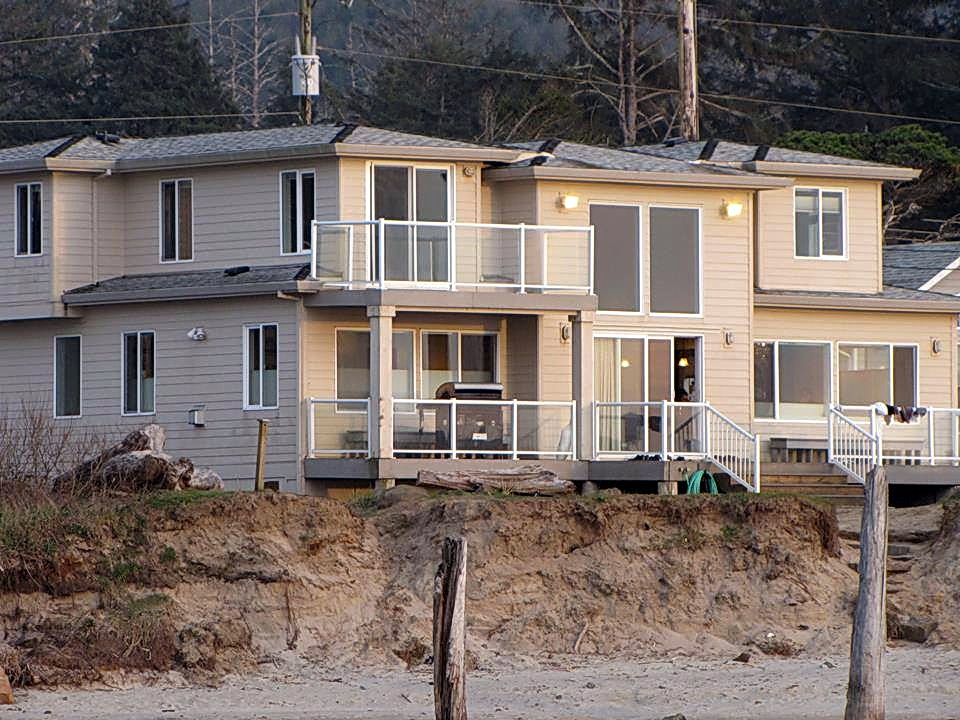By Phillip Johnson, Executive Director, Oregon Shores Conversation Coalition
For several years now, the Oregon Shores Conservation Coalition has been struggling along with local residents to prevent the riprapping of a structure in Rockaway Beach that never should have been built. The owner’s application to make permanent the temporary riprap he has already been allowed is the final opportunity to block shoreline armoring for the property and protect the integrity of Statewide Planning Goal 18, which covers beaches and dunes and includes regulations for shoreline armoring such as riprap. In one sense, the issue is just whether one stretch of shoreline will be damaged, but in another sense, this is a test of whether the state of Oregon will ever apply its land use laws to protect the public beach.
The Oregon Parks and Recreation Department (OPRD) will hold a hearing on Tuesday, May 21, 6 p.m. in the Rockaway Beach City Hall Civic Facility (276 Hwy 101), on the application by landowner Tai Dag for a shoreline protection structure. Members of the public will be able to testify.
It is also possible to comment for or against the proposal by mail or e-mail. Comments should be sent by mail to Calum Stevenson, Oregon Parks and Recreation Department, 12735 N.W. Pacific Coast Highway, Seal Rock, OR 97376, or via e-mail to calum.stevenson@oregon.gov.
At one point it appeared that owner Tai Dang’s attempts to armor the shoreline to protect his house at 211 S. 6th St. had been successfully thwarted. The City of Rockaway Beach refused to certify that his property qualified for armoring in accordance with the city’s comprehensive plan, and State Parks followed by denying his application to intrude on the public shoreline with a riprap structure. However, Dang successfully sued the city, which was forced to accept that the property qualified for riprap in terms of the permit it earlier issued for his house (violating its own plan), whereupon, in January, State Parks granted him permission to install a temporary 81-foot-long wall of riprap. He is now applying to make that “emergency” permit permanent.
The issue now is whether the city’s error in originally granting Dang a permit outweighs the public’s right to preserve its public beach, which would be damaged by the shoreline armoring for a building that should not have been allowed in the first place. There is no question that the structure is severely threatened; the question is whether a developer can in effect play chicken with the authorities, building in a foolish location in violation of all setback provisions and then daring them to allow the vulnerable structure to collapse.
The case has a long, convoluted history stretching back several years. Developer Dang (and two partners) built the structure very close to the edge. The location clearly violated the city’s beach setback ordinance. However, a part-time planner with the city, using absurd logic that made a mockery of the city’s clear intentions under its comprehensive plan, granted a permit. When Dang subsequently applied for a permit to riprap the structure, because the low dune it is built on was rapidly eroding (which is why it should never have been built), the city refused to authorize shoreline armoring because a new, more diligent planner realized that the house’s location violated the land use plan. However, Dang sued the city and won a court decision that his house had been permitted, even if erroneously, and thus must be declared eligible for riprap by the city.
State Parks (the Oregon Parks and Recreation Department), which manages Oregon’s public shoreline, is charged with issuing permits based on its own regulations and on consistency with statewide planning goals. While the threat to the house from erosion is real, if the house was constructed in a location that violated the city’s plan, Oregon Shores argues that it should not qualify for protection under state law. In other words, whatever the city of Rockaway Beach’s problems with Mr. Dang, they don’t prevent the state from refusing to allow the shoreline to be damaged in violation of the intent of the state’s land use laws.
Oregon Shores members and other opponents argue that the public shouldn’t lose part of its beach to protect a structure that should not have been built in that location. Moreover, neighbors are concerned that an armored shoreline in front of this lot will deflect waves and cause erosion on neighboring properties (including a public beach access) and possibly further up Saltair Creek (immediately north of the property). While Dang and the other owners did receive permission to install temporary riprap on an emergency basis in the wake of the court decision, the current application process before State Parks presents an opportunity to make the case that the public interest, and the potential damage to neighbors, should prevail over the error that allowed the structure to be placed in this foolish location.
For more information about the Dang house Rockaway Beach riprap issue, go to https://oregonshores.org/article/rockaway-riprap-case-threatens-public-shoreline.


